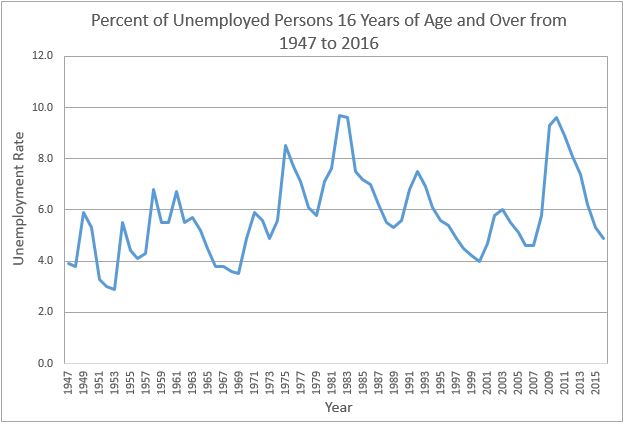Healthy and Unhealthy Unemployment
The United States unemployment rate has fallen dramatically over the past decade. Last month the official rate was 4.3 percent, down from 9.6 percent in 2010. Economists refer to today's rate as the "
full employment rate". Yet we read that unemployment is a problem and there are many long-term unemployed. Are these statements conflicting? No; both are true. The unemployment rate has fallen, but there are many unemployed who are not included in the unemployment rate, and the economy has passed them by. To understand, it is helpful to understand the unemployment rate and the difference between frictional, structural, and cyclical unemployment.

Source:
BLS Table 1Who is classified as unemployed?
The Bureau of Labor Statistics defines an unemployed person as:
Persons aged 16 years and older who had no employment during the reference week, were available for work, except for temporary illness, and had made specific efforts to find employment sometime during the 4-week period ending with the reference week. Persons who were waiting to be recalled to a job from which they had been laid off need not have been looking for work to be classified as unemployed. BLS Glossary
To be classified as unemployed, a person must be at least 16, not have a job, be willing to work, and done at least one thing in the prior four weeks to prove he or she is actively looking for a job. Frequently the unemployment rate will increase when the economy begins to improve and people find jobs. Why? Because a healthy economy pulls workers back into the labor force. Returning workers were not considered unemployed before if they are seeking employment for the first time in a long time. It is important to read the change in the labor force when analyzing an unemployment rate.
Even a healthy economy must have some unemployment. Economists view an unemployment rate of between 3.5 and 5 percent as being the full-employment rate. The largest group included in the full-employment unemployment rate is the frictionally unemployed.
Who is frictionally unemployed?
Assume you are employed, but dissatisfied with your work. You choose to seek other opportunities, confident you will be able to find another job soon. You would be
frictionally unemployed after resigning from your job.
Workers change jobs. People enter and reenter the work force, such as students seeking a job following graduation, or mothers reentering the labor force. It takes time to match potential employees and employers. The applicant must search for a job, apply, and probably interview for a job. Employers may want to consider many applicants. This is a period of frictional unemployment.
Unlike structural and cyclical unemployment, frictional unemployment does not harm the economy. In fact, frictional unemployment is healthy because it normally results from people seeking better jobs. Most of the time frictional unemployment is voluntary, so it is just a natural progression of people choosing where they want to work. Frictional unemployment normally increases following a recession because confidence in the economy increases people's willingness to quit a job in search for a better one. Conversely, people may be hesitant to leave a job during a recession, fearing they will not find one to replace it.
Frictional unemployment can be reduced by decreasing the time it takes for job seekers to find a job. Job placement companies such as Monster and CareerBuilder have improved the efficiency of identifying potential jobs.
Who is structurally unemployed?
Economies evolve. Technology replaces people. Work is subcontracted to another company. Workers lose their jobs.
Structural unemployment does not require a decrease in production. In fact, production may increase because of advances in technology. Structural unemployment is caused by the obsolescence of workers' skills due to technology or other factors that reduce the demand for their skills. Structural unemployment is not influenced by changes in the business cycle. An increase in the demand for goods or services will not bring the structurally employed back to work, which means those impacted may be out of work for a long time.
Many structurally unemployed become long-term unemployed when they become discouraged that the demand for their skills is gone or diminished to a point where they are unable to earn what they were accustomed to. Sadly, many give up and choose to not seek employment until the economy improves or an opportunity presents itself. These individuals would not be considered "unemployed" by the Bureau of Labor Statistics.
Technology has displaced workers for centuries. Agricultural equipment has replaced sharecroppers. Word processing software, answering machines, and other office technology has replaced many secretaries. Historically, workers have adjusted by acquiring new skills for new jobs. But as jobs become more complex and require more training it becomes harder to find new jobs. Structural unemployment occurs when the skills of a worker become obsolete and are no longer in demand due to advanced technologies. Jobs are available, but there is a disparity between the skills required and what the workers can offer, or between the location of the job and the inability of the worker to move to the area. For example, the demand for people manning a drill press is less, while the demand has increased for computer programmers to program the robot that has replaced the drill press operator. Unfortunately, the drill press operator may not have the skills to program the robot.
In another case, assume management chooses to outsource the manufacturing process to another company to lower their cost. The other manufacturer has a demand for drill press operators, but the laid off drill press operator may be unable to move. The drill press operator illustrates the primary difference between frictional and structural unemployment. Frictional unemployment normally occurs when someone with transferable skills decides to look for a different job. (Someone would be reluctant to leave their job unless they were qualified.) Structural unemployment happens when someone lacks the needed expertise. This makes structural unemployment longer and more difficult to remedy. Structural unemployment is the primary cause for long-term unemployment. Any solution involves either providing an employee the needed skills in the changing economy or the ability to identify and move to an area with the jobs matching his skills.
Management may choose to move manufacturing following a trade agreement, tax policy, or regulations that increase cost. Each of these actions could potentially increase structural unemployment in a region.
Who is cyclically unemployed?
The
cyclically unemployed lost their jobs because of dips in the business cycle. It increases during recessions. The demand for goods and services contracts. Inventories increase. Managements slow production and lay off workers to cut costs, causing a surplus of workers. Conversely cyclical unemployment decreases during expansions when businesses need to hire workers to increase production. Cyclical unemployment is zero at full employment. Cyclical unemployment is more volatile than frictional and structural unemployment so cyclical unemployment has a greater influence over changes in the unemployment rate.
Expansionary fiscal and monetary policies can be used to increase the economy's aggregate demand and return many of the cyclically unemployed back to work. The Federal Reserve may increase the money supply to lower interest rates, which in turn makes business borrowing more attractive. Congress may choose to stimulate the economy by increasing spending.

